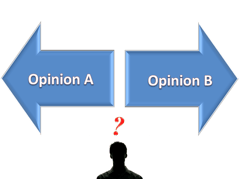May 8, 2018

So far, our Tips series has focused on setting the stage for effective voir dire (Tip 1; Tip 2; and Tip 3), capitalizing on open-ended questions to increase our understanding of jurors (Tip 4), avoiding the “looking good” bias (Tip 5), and crafting questions with the “bad” answer in mind (Tip 6). Our next tip addresses asking questions that contrast important positions within the same question. (Click here to see a short video for this tip.)
Contrasting Viewpoints or Positions
The primary goal of voir dire and jury selection is to identify potential jurors who have a favorable or unfavorable initial orientation toward your case, ideally based on their beliefs, opinions, and values. Often the questions asked of jurors in pursuing this goal address a single value, position, or viewpoint. For example, “How many of you believe that the most important goal of sentencing in our criminal justice system is to punish those convicted of violent crimes?” Addressing a single position or viewpoint in one question has value, but this is not the only way to uncover critical opinions held by jurors. An alternate method is to contrast potentially opposing positions or viewpoints in the preface to the question and then ask jurors to choose which position is closer to their own. Consider the following examples.
“There are several viewpoints on the importance of various goals in our criminal justice system for the sentencing of those convicted of violent crimes. One view is that the most important goal is to punish those who commit violent crimes. A second view is that the most important goal is to rehabilitate those who commit such crimes. (It is possible to add other goals here.) Which of these viewpoints is closer to your view?”
“There are several viewpoints on providing money for pain and suffering. One view is that little or no money should be given for emotional suffering because it does not make the emotional suffering go away. Another view is that money should be given for emotional suffering reflecting the amount of this suffering. Which of these views is closer to your own?”
In each of the above examples, jurors are presented with competing positions and asked to choose the position closest to their own.
Hey, Why Not Make It “Personal?”
The above approach can be refined even further to include an expectation of support for the contrasting viewpoints. This refinement simply involves attaching phrases to each option telling jurors that there are “others” who hold a given position. Adding phrases such as “Some people/jurors believe . . .” and “Other people/jurors believe . . .” encourages identification and disclosure of support for the positions presented. The following illustrates the more personalized approach.
“There are several viewpoints on the importance of various goals in our criminal justice system for the sentencing of those convicted of violent crimes. Some people/jurors feel that the most important goal of sentencing is to punish those who commit violent crimes. Other people/jurors feel that the most important goal of sentencing is to rehabilitate those who commit such crimes. Which of these viewpoints is closer to your own?”
“There are several views on providing money for pain and suffering. Some people/jurors feel that little or no money should be given for emotional suffering because it does not make the emotional suffering go away. Other people/jurors feel that money should be given for emotional suffering reflecting the amount of this suffering. Which of these views is closer to your own?”
So, What’s the Benefit to Me?
There are several benefits to employing the contrasting positions approach in voir dire. First, by contrasting positions, jurors are presented with two (or more) “legitimate” options. Each position is “normalized,” which encourages jurors to endorse the position presented that most closely matches their own view.
Second, particularly with the more personalized approach, jurors have an expectation that someone else in the jury pool will feel as they do (both in individual voir dire and, especially, in group voir dire). This anticipation of agreement by “others” encourages jurors to select an option (e.g., by raising their hands) that reflects their true feelings/viewpoints.
Third, the contrasting positions approach forces jurors to choose from among competing positions/options. Not only does this approach identify jurors who strongly support certain positions, it identifies jurors who would lean one way or the other when push comes to shove. This latter effect is of no small value. Knowing that a juror prefers an unfavorable viewpoint or position as compared to a favorable viewpoint when forced to choose becomes a critical additional factor when considering your jury selection decisions.
Finally, the contrasting positions approach can be a valuable tool to use when leaving a critical topic area during voir dire questioning. Such questions can act as a final exit poll for viewpoints on critical issues, thereby capturing each juror’s view on the issue. Of course, a slight modification can further personalize and capitalize on the above benefits. Consider how the following exit questions not only capture each juror’s view on the opposing positions but they tie them to examples of the jurors who hold them.
<at the end of questioning on a critical topic>
“So, in terms the views on <critical topic>, I see that some jurors, including Ms. Smith and Mr. Fields, feel that . . . <position>. Other jurors, including Mr. Jones and Ms. Frost, feel that . . . <contrasting position>.”
“How many of you agree with (or have similar views as) Ms. Smith and Mr. Fields that . . . <one position>?”
“How many of you agree with (or have similar views as) Mr. Jones and Ms. Frost that . . . <contrasting position>?”
Wait . . . What About Other Forms of Questioning?
In this blog and in the recently released fourth edition of my book, I address various forms of questions and questioning techniques. For example, I consider the value of open-ended questions versus closed-ended questions in Tip 4 and the value of asking questions with the “bad” answer in mind in Tip 6. They all have their place in jury selection. These tips and other discussions enable you to tailor your approach to voir dire questioning both in terms of what is needed and what is allowed to maximize your effectiveness in voir dire and jury selection.
We will be covering additional tips in the months to come. Check out our introductory two-minute video, Tip 1, Tip 2, Tip 3, Tip 4, Tip 5, Tip 6, and the video for Tip 7.
For more information on voir dire and jury selection, see Mastering Voir Dire and Jury Selection: Gain an Edge in Questioning and Selecting Your Jury, Fourth Edition (2018). Also, check out my companion book on supplemental juror questionnaires, Mastering Voir Dire and Jury Selection: Supplemental Juror Questionnaires (2018).



